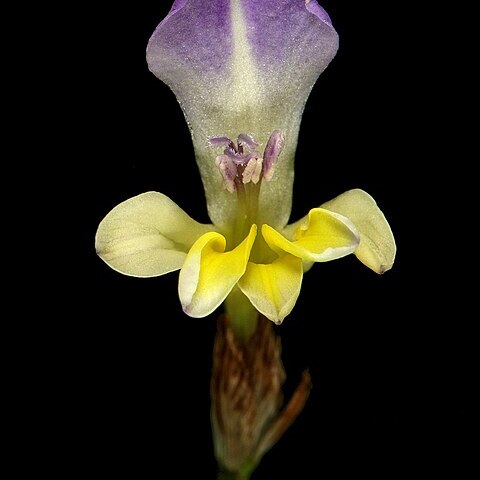Plants 150-350 mm high. Corm 9-15 mm diam., tunics of hard, coarse fibres, netted above, thickened and vertical below, often forming claw-like ridges. Stem simple or with 1 branch from axil of cauline leaf. Leaves 5 to 7, mostly in a basal fan, uppermost inserted in middle of stem, narrowly lanceolate, obliquely apiculate, reaching to between middle of stem and base of spike, 5-15 mm wide, sheathing lower part of stem. Spike weakly flexuose, subsecund, 2-to 4-flowered; bracts pale below with whitish veins, becoming irregularly streaked light brown above, outer 15-25 mm long, ± 3 cuspidate with central cusp prominent, becoming irregularly lacerate, inner ± as long as outer, with 2 prominent cusps. Flowers zygomorphic, creamy yellow with dorsal tepal violet in upper half and lower tepals deep yellow fading to cream-coloured at tips, abaxial half of throat streaked yellow and violet, unscented; perianth tube obliquely funnel-shaped, upper part curving outward, (12-)15-16 mm long; tepals unequal, dorsal largest, erect to slightly hooded, (10)15-16 x 9-10 mm, upper laterals ± 12 mm long, directed forward, lower 3 tepals united basally for ± 2 mm, ± horizontal below, ± 10 mm long, channelled and flexed downward distally. Stamens unilateral, arcuate; filaments ± 13 mm long, white; anthers violet above, cream-coloured below, ± 3 mm long, fully exserted; pollen ± white. Ovary 4-5 mm long, oblong-trigonous; style arched over filaments, purple, dividing just below or opposite anther bases, branches ± 2 mm long, ascending, recurved distally, ciliate along margins ± to base, slightly expanded distally. Capsules barrel-shaped, ± 12 x 6-7 mm. Seeds 1.7-2.1 mm diam., light brown, (8)9 or 10 per locule.
More
Herb 10–35 cm high. Corm to 1.5 cm diam.; tunic of hard netted strands. Leaves 5–7, basal, narrowly oblanceolate, ± obtuse, 5–20 cm long, 5–15 mm wide, glabrous. Spike ± flexuose, 2–4-flowered. Bracts lacerate with fine acuminate cusps, dentate, 1.5–2.5 cm long, ± colourless below, brown in upper half. Flowers sulphur yellow, the dorsal lobe and often the apices of lower lobes mauve. Perianth tube narrow in lower half, widened above, 1.5–2 cm long; dorsal perianth lobe obovate, often emarginate, concave, 1.4–1.9 cm long; other lobes oblong to oblanceolate, slightly recurved, the laterals 1–1.4 cm long, the lowermost 7-9 mm long. Filaments c. 1.5 cm long; anthers oblong, 4 mm long. Ovary 4–5 mm long; style branches reaching middle of anthers, spathulate, 3 mm long.
Cormous geophyte, 12-35 cm, tunics clawed below. Leaves lanceolate, often obtuse. Flowers zygomorphic, small, yellow, upper tepals purple.

